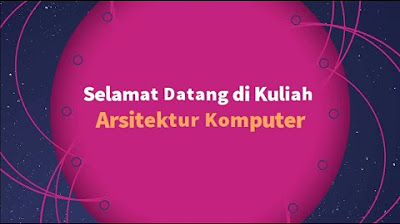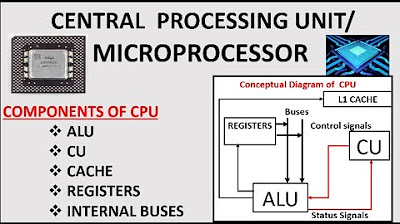CH01_VID02_CPU Components & Lifecycle
Summary
TLDRThe script explains the Central Processing Unit (CPU) using the acronym 'CPU' and delves into its components and life cycle. It introduces the Fetch-Decode-Execute cycle, where the CPU fetches instructions from memory, decodes them to understand operations like addition or subtraction, and then executes these operations. The script also touches on registers, accumulators, and the significance of binary code in computing, providing a foundational understanding of how a CPU processes information.
Takeaways
- 🧠 The term 'CPU' stands for 'Central Processing Unit', which is considered the brain of a computer.
- 🔍 Understanding the CPU requires knowledge of two main components: the components within the CPU and the life cycle.
- 🔁 The life cycle involves the set of operations that the processor performs, which may be repeated until it reaches a result or an instruction.
- 🐟 The 'Fetch' operation is part of the control unit and is responsible for retrieving the instruction from memory.
- 📍 The 'Program Counter' (PC) holds the address of the instruction that needs to be fetched from memory.
- 🔗 The 'Instruction Register' (IR) is responsible for holding the fetched instruction, which is then decoded.
- 🔢 The 'Decoder' is a part of the control unit that interprets the instruction's format and determines how it should be executed.
- 💾 The 'Memory' stores the instructions and data that the CPU uses to perform operations.
- 🔧 The 'Execution' phase is where the actual operation, such as addition, subtraction, or any other arithmetic or logical operation, is performed.
- 🔄 The 'Write-back' phase is where the result of the operation is stored back into the register, completing the life cycle of the CPU.
Q & A
What does CPU stand for?
-CPU stands for Central Processing Unit, which is considered the brain of a computer.
What are the two main components of a CPU?
-The two main components of a CPU are the Arithmetic Logic Unit (ALU) and the Control Unit (CU).
What is the function of the ALU?
-The ALU performs arithmetic and logical operations on data.
What is the role of the Control Unit in a CPU?
-The Control Unit manages the flow of data between the ALU and memory, interpreting and executing instructions.
What is a Life Cycle in the context of CPU operations?
-A Life Cycle refers to the series of operations a processor goes through to execute a single instruction.
What is meant by 'fetch' in the context of the CPU's Life Cycle?
-Fetch is the process where the CPU retrieves an instruction from memory.
What is the purpose of the Instruction Register?
-The Instruction Register holds the instruction that the CPU is currently executing.
How does the CPU decode instructions?
-The CPU decodes instructions using the Instruction Decoder, which interprets the binary code and determines the operation to be performed.
What are the two main types of codes that the CPU works with?
-The CPU works with two main types of codes: the opcode, which indicates the operation to be performed, and the operand, which is the data on which the operation is performed.
What is the role of the ALU in executing operations?
-The ALU performs the actual arithmetic or logical operation as specified by the opcode and operand.
What is the significance of the 'execute' phase in the CPU's Life Cycle?
-The 'execute' phase is where the CPU carries out the operation decoded in the previous phase, such as addition, subtraction, or data movement.
Outlines

This section is available to paid users only. Please upgrade to access this part.
Upgrade NowMindmap

This section is available to paid users only. Please upgrade to access this part.
Upgrade NowKeywords

This section is available to paid users only. Please upgrade to access this part.
Upgrade NowHighlights

This section is available to paid users only. Please upgrade to access this part.
Upgrade NowTranscripts

This section is available to paid users only. Please upgrade to access this part.
Upgrade Now5.0 / 5 (0 votes)





